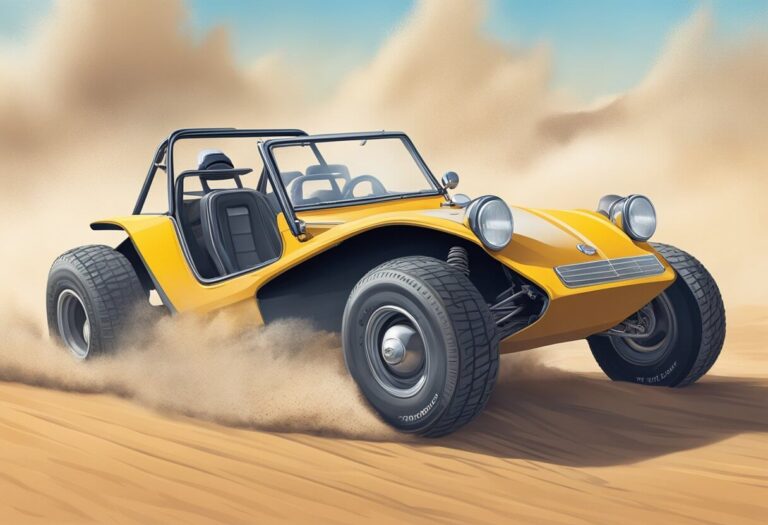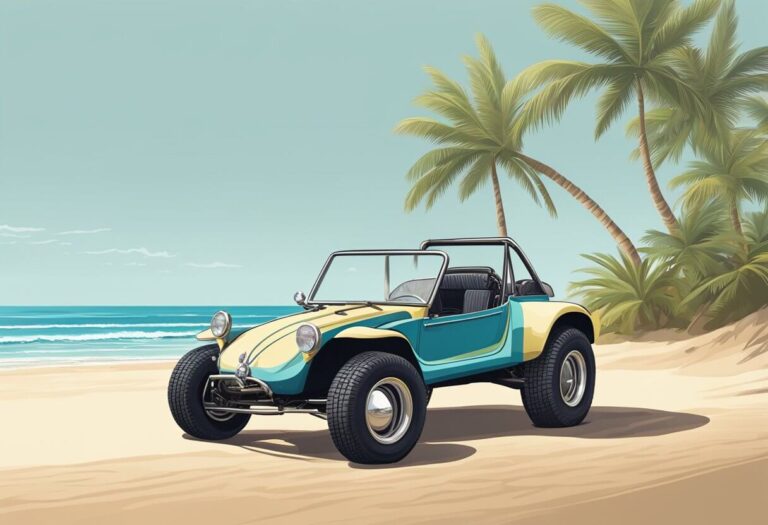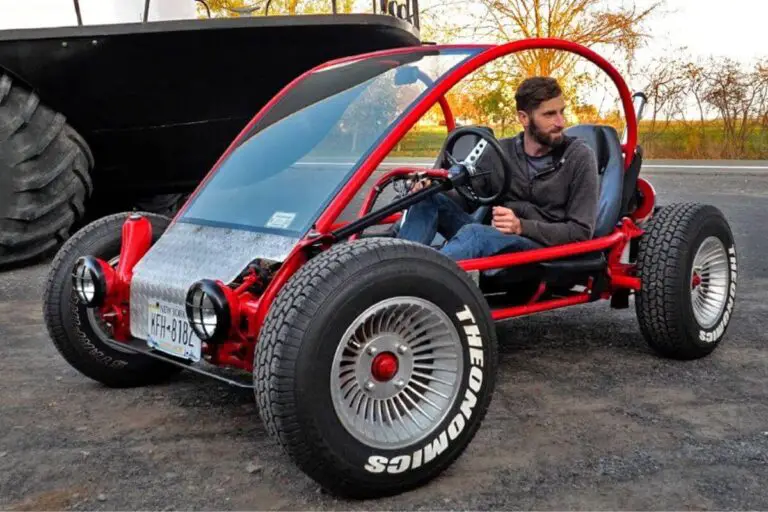Dune Buggy Volkswagen Beetle: Ultimate Off-Road Experience
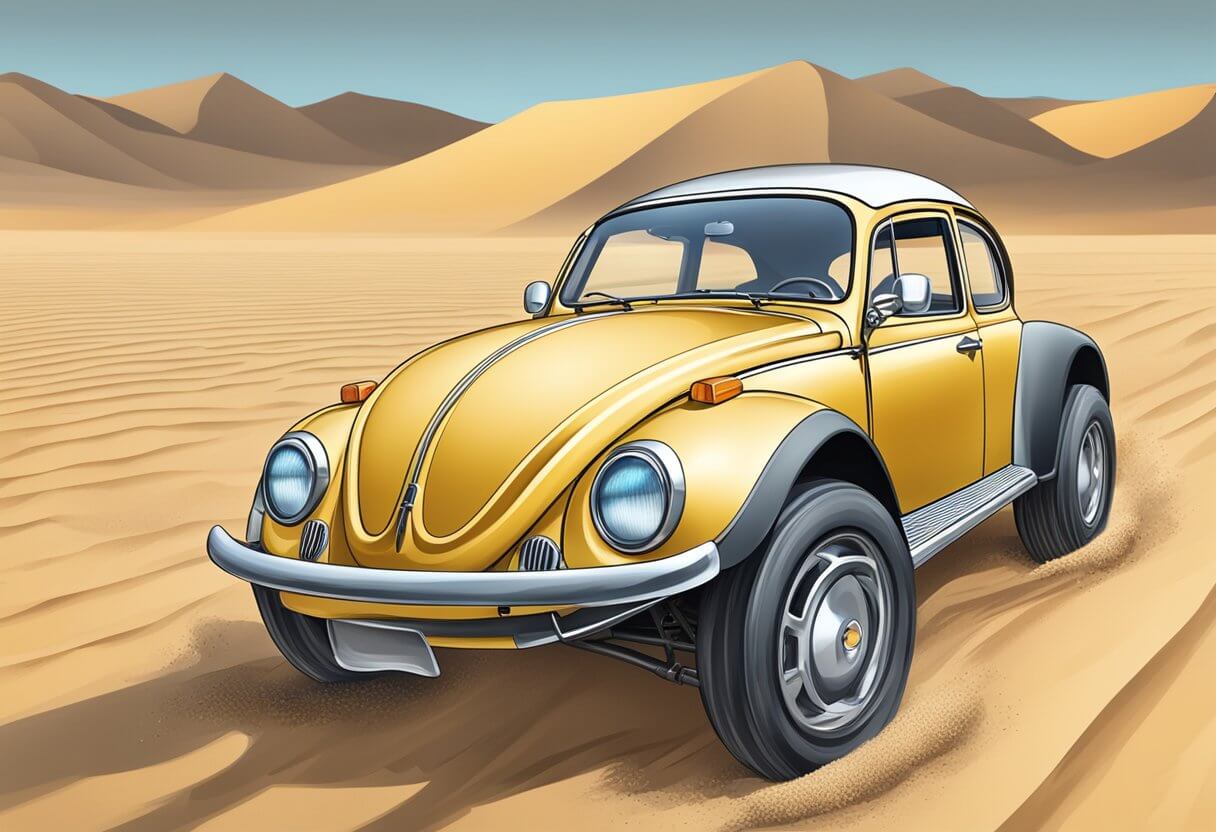
Dune buggies have been around for decades and are still popular among off-road enthusiasts today. One of the most iconic dune buggies is the Volkswagen Beetle dune buggy. The Volkswagen Beetle dune buggy is a classic and beloved vehicle that has been modified to handle rough terrain and sand dunes.
The Volkswagen Beetle dune buggy is a modified version of the classic Volkswagen Beetle, which was first introduced in 1938. The dune buggy version of the Beetle was popularized in the 1960s and 1970s, when people began modifying Beetles to create off-road vehicles that could handle sand and other rough terrain. These modified Beetles were often stripped down to their bare essentials, with no roof or doors, and were outfitted with large, off-road tires and other modifications to make them more capable off-road.
Today, the Volkswagen Beetle dune buggy remains a popular vehicle among off-road enthusiasts. While many dune buggies are custom-built, there are also many companies that specialize in building and selling Volkswagen Beetle dune buggies. These vehicles are often used for off-road racing, as well as for recreational purposes. With their unique look and impressive off-road capabilities, the Volkswagen Beetle dune buggy is a true classic that will continue to be popular for years to come.
History of Dune Buggies
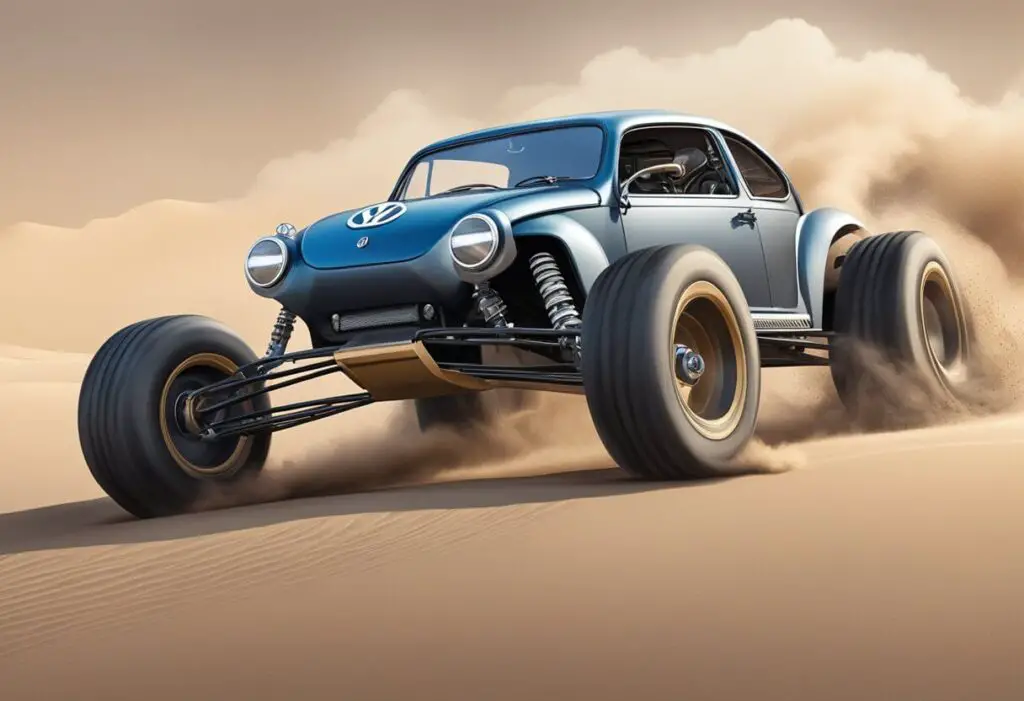
Volkswagen Beetle’s Role
The Volkswagen Beetle played a significant role in the history of dune buggies. In the late 1950s and early 1960s, people began removing the bodies of Volkswagen Beetles and replacing them with custom fiberglass shells to create dune buggies. The Beetle’s rear-mounted engine made it an ideal choice for this type of modification.
The Beetle’s popularity as a base for dune buggies continued to grow, and in 1964, Bruce Meyers designed and built the first Meyers Manx dune buggy. The Manx was built on a shortened Beetle chassis with a fiberglass body and a unique, stylish design. The Meyers Manx was an instant success, and it became a cultural icon of the 1960s.
Evolution of Dune Buggy Design
Over the years, dune buggy design has evolved significantly. While early dune buggies were built on Beetle chassis, modern dune buggies are often built on custom frames. Advances in technology have also led to the development of more powerful engines and sophisticated suspension systems.
Today, dune buggies are used for a variety of purposes, from racing to off-road adventures. They are popular among enthusiasts who enjoy customizing and modifying their vehicles. The Volkswagen Beetle’s role in the history of dune buggies is undeniable, and its legacy continues to inspire new generations of enthusiasts.
Dune Buggy Basics
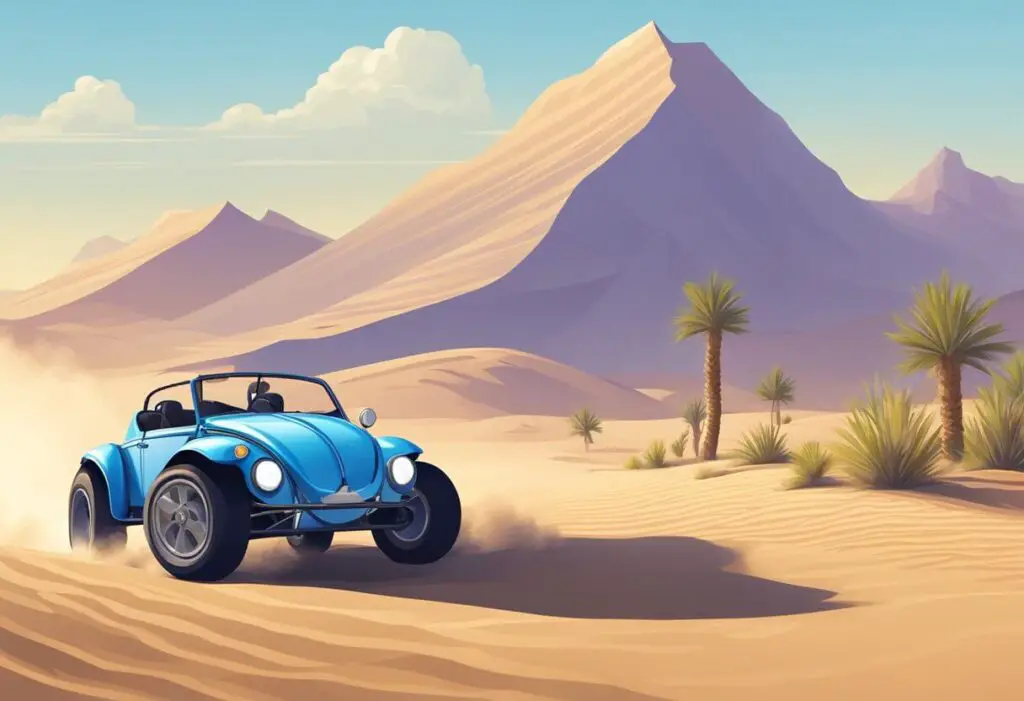
Defining Characteristics
Dune buggies are lightweight, open-air vehicles designed for off-road use. They typically feature a tubular steel frame and a fiberglass or aluminum body. They are known for their high ground clearance, large wheels and tires, and minimalistic design. Dune buggies are often used for recreational purposes, such as exploring sand dunes and beaches.
One of the defining characteristics of dune buggies is their ability to handle rough terrain. They are designed to navigate sand, mud, and other challenging environments. Dune buggies are also known for their agility and maneuverability, thanks to their lightweight construction.
Types of Dune Buggies
There are several types of dune buggies, each with its own unique characteristics. One of the most popular types is the Volkswagen Beetle-based dune buggy. These buggies use the chassis and engine of a VW Beetle, but are heavily modified to suit off-road use. They are often referred to as “Baja Bugs” and are a common sight in off-road racing events.
Another type of dune buggy is the sand rail. These buggies are typically built from scratch and feature a long, narrow frame and a powerful engine. Sand rails are designed for speed and are often used in desert racing.
Finally, there are street legal dune buggies, which are designed for both on- and off-road use. These buggies meet all the necessary safety requirements for street use and are often used as daily drivers.
Overall, dune buggies are a fun and exciting way to explore the great outdoors. Whether you’re racing across sand dunes or cruising down the highway, a dune buggy is sure to turn heads and provide a thrilling ride.
Building a Dune Buggy

Building a dune buggy can be an exciting and rewarding project for those who enjoy tinkering with cars. The Volkswagen Beetle is a popular choice for a dune buggy, due to its simple design, rear-mounted engine, and affordability. In this section, we will discuss the steps involved in building a dune buggy using a Volkswagen Beetle.
Selecting a Volkswagen Beetle
The first step in building a dune buggy is selecting a suitable Volkswagen Beetle. It is recommended to choose a Type 1 Volkswagen Beetle as it is the perfect size and shape for a dune buggy. If you get a good car, most of the important parts are reusable, so you don’t have to purchase or assemble them yourself. In addition to the chassis, you could save the seats, brakes, engine, and other parts.
Essential Modifications
Once you have selected a Volkswagen Beetle, the next step is to make essential modifications. For a classic dune buggy, you’re going to have to shorten the chassis by 14.5 inches. If you don’t want the hassle of finding a Bug and altering the chassis, you can buy a tube chassis. It will take a little patience to find a suitable tube chassis on eBay because there’s not a dedicated category for them. Other modifications include installing a roll cage, reinforced suspension, and larger tires for better traction on sand.
Safety Considerations
Building a dune buggy requires a lot of work, and it is essential to take safety precautions. It is recommended to wear protective gear such as gloves, goggles, and a respirator when working with fiberglass and other materials. It is also important to use high-quality components and parts to ensure the safety of the driver and passengers. Additionally, it is recommended to have the dune buggy inspected by a professional before taking it out for a ride.
Legal and Regulatory Considerations

Street Legality
Dune buggies, which are commonly built on top of a Volkswagen Beetle chassis, are designed for off-road use and are often used for recreational activities such as beach driving and desert racing. However, the legality of driving dune buggies on public roads varies depending on federal and state regulations, as well as local laws.
In California, for example, dune buggies are street legal as long as they meet certain requirements. According to the California Department of Motor Vehicles, dune buggies must have certain safety features, such as seat belts and a roll cage, and must be registered with the DMV. Additionally, dune buggies must comply with certain emissions standards and noise regulations.
You should be aware that dune buggies are subject to different laws in each state. They can also vary depending on the county or city. Before operating a dunny on a public road, it’s important to know the local laws.
Off-Roading Regulations
While dune buggies are designed for off-road use, there are still regulations that must be followed when operating them in off-road areas. For example, many off-road areas require a permit or registration for vehicles, including dune buggies. Additionally, some areas may have specific rules regarding the types of vehicles that are allowed, such as restrictions on noise levels or size.
It is important to research and understand the specific regulations for the off-road area you plan to visit. Following these regulations not only ensures compliance with the law but also helps protect the environment and preserve the area for future generations.
Maintenance and Care
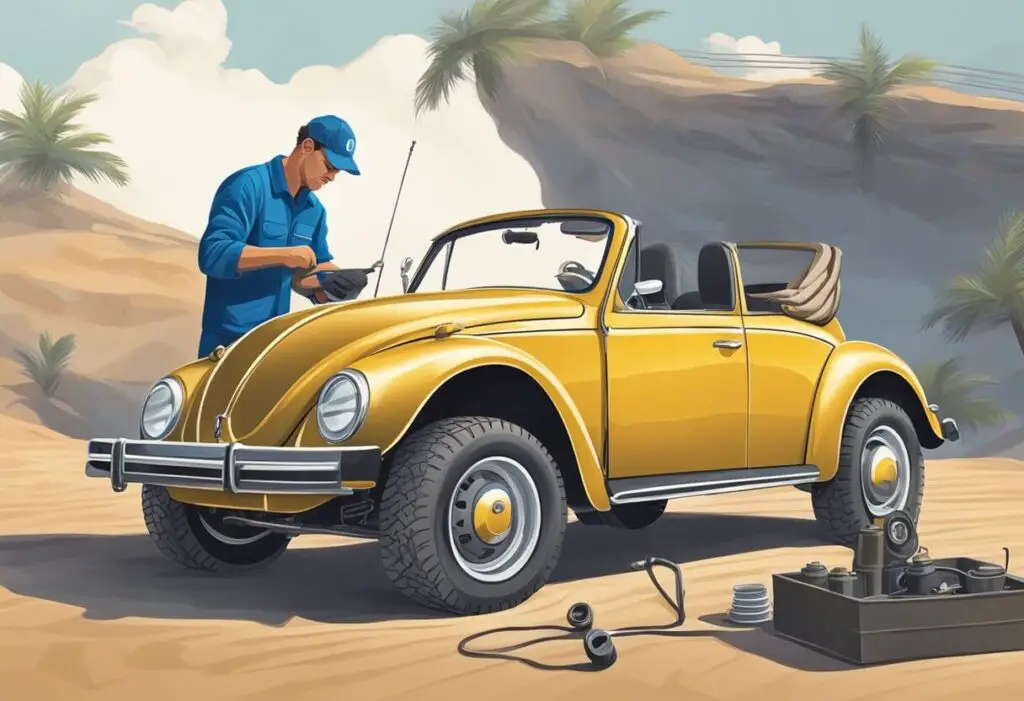
Routine Upkeep
To ensure the longevity of a dune buggy Volkswagen Beetle, regular maintenance is essential. Here are some routine upkeep tasks that should be performed:
- Oil changes: Regular oil changes are necessary to keep the engine running smoothly. The oil should be changed every 3,000 to 5,000 miles, depending on the type of oil used.
- Air filter replacement: The air filter should be replaced every 12,000 to 15,000 miles or more frequently if the vehicle is driven in dusty conditions.
- Spark plug replacement: Spark plugs should be replaced every 30,000 miles or as recommended by the manufacturer.
- Tire maintenance: Tires should be checked for proper inflation and wear. Rotation and alignment should be performed as recommended by the manufacturer.
- Brake inspection: Brakes should be inspected regularly to ensure they are functioning properly. Brake pads should be replaced when they are worn down to the minimum thickness.
Troubleshooting Common Issues
Despite regular maintenance, dune buggy Volkswagen Beetles may experience some common issues. Here are some troubleshooting tips:
- Engine won’t start: Check the battery to ensure it has a charge. If the battery is good, check the spark plugs and fuel system.
- Overheating: Check the coolant level and ensure the radiator is functioning properly. If the radiator is clogged or damaged, it may need to be replaced.
- Electrical issues: Check the fuses and wiring to ensure they are not damaged or corroded. If the issue persists, it may be necessary to consult a professional.
- Suspension problems: Check the shocks and struts for wear or damage. If they are worn, they may need to be replaced.
By following these routine upkeep tasks and troubleshooting tips, owners can ensure their dune buggy Volkswagen Beetle remains in top condition for years to come.
Dune Buggy Culture and Community

Racing and Recreation
Dune buggy racing is a popular pastime for many enthusiasts. The sport involves driving buggies across sandy terrain, often in a competitive setting. Races can be held on beaches, dunes, or specially designed tracks. In addition to racing, many dune buggy owners enjoy recreational driving across sandy terrain. The Volkswagen Beetle dune buggy is a popular choice for both racing and recreation due to its lightweight design and off-road capabilities.
Clubs and Gatherings
The dune buggy community is a tight-knit group of enthusiasts who share a passion for off-road driving and customization. There are many clubs and gatherings across the country where owners can come together to share tips, show off their vehicles, and participate in group drives. These clubs often organize events such as races, rallies, and camping trips. Some of the most popular clubs include the American Buggy Association, the International Dune Buggy Association, and the Meyers Manx Club.
Overall, the dune buggy community is a welcoming and supportive group that is passionate about off-road driving and customization. Whether you are a seasoned racer or a novice enthusiast, there is a place for you in this vibrant community.
Frequently Asked Questions
How can I find street-legal dune buggies for sale in my area?
It is recommended that you check with your local DMV to see if street-legal dune buggies are allowed in your state. If they are, you can search online for dealerships or private sellers in your area who specialize in dune buggies. Websites such as Craigslist and eBay are also good resources to find street-legal dune buggies for sale.
What are the typical specifications of a Volkswagen Beetle dune buggy?
Volkswagen Beetle dune buggies typically have a fiberglass body, a modified VW Beetle chassis, and a rear-mounted air-cooled engine. They usually have an open cockpit and are designed to be driven off-road. They can vary in size and weight depending on the modifications made to the chassis and body.
Where can I purchase parts for a VW dune buggy?
There are many online retailers that specialize in VW dune buggy parts and accessories. Some popular websites include Dune Buggy Warehouse, Appletree Automotive, and Chirco Performance. Local auto parts stores may also carry some parts for VW dune buggies.
What is the average price range for a Volkswagen Beetle dune buggy?
The price of a VW Beetle dune buggy can vary greatly depending on the condition, modifications, and location. On average, a used VW Beetle dune buggy can range from $4,995, to $25,000. Newer models or highly modified buggies can sell for significantly more.
Are there any specific models of VW Beetle dune buggies that are considered collectible?
Yes, there are certain models of VW Beetle dune buggies that are considered collectible, such as the Meyers Manx. The Meyers Manx is one of the original and most iconic dune buggies, designed by Bruce Meyers in the 1960s. Other collectible models include the Berrien Buggy and the Edge Dune Buggy.
What should I look for when buying a used VW Beetle dune buggy?
When buying a used VW Beetle dune buggy, it is important to inspect the chassis, engine, and body for any signs of wear or damage. Check the brakes, suspension, and steering to ensure they are in good working condition. It is also important to check the wiring and electrical components, as these can be prone to issues in older buggies. Finally, take the buggy for a test drive to ensure it runs smoothly and handles well off-road.

